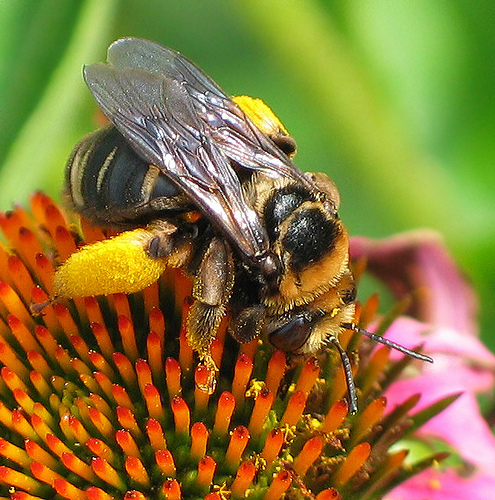.
Posted “Autumn 2011” (September), by Jason Mark, Earth Island Journal (Earth Island Institute), earthisland.org
.
 Kieran Suckling doesn’t suffer fools gladly. As the founding director of the Tucson-based Center for Biological Diversity(CBD), Suckling is often invited to represent the environmentalist position on cable news shows, national radio programs, and at public debates. Employing a combination of acerbic wit, lighting intelligence, and red-hot passion, Suckling usually flattens his adversaries from the logging, mining, and fossil fuel industries. He’s a rhetorical pugilist who knows that it takes muscle to win arguments in today’s shout-fest public discourse.
Kieran Suckling doesn’t suffer fools gladly. As the founding director of the Tucson-based Center for Biological Diversity(CBD), Suckling is often invited to represent the environmentalist position on cable news shows, national radio programs, and at public debates. Employing a combination of acerbic wit, lighting intelligence, and red-hot passion, Suckling usually flattens his adversaries from the logging, mining, and fossil fuel industries. He’s a rhetorical pugilist who knows that it takes muscle to win arguments in today’s shout-fest public discourse.
Suckling’s street-fighting skills are a major asset for the green movement – until he turns them on putative allies. Suckling has boasted that CBD is “like fire and wolves and Apaches to big environmental groups.” Not surprisingly, that attitude has made some greens uncomfortable. It has also made CBD one of the most successful environmental outfits around, a group with a string of victories protecting wilderness. “Uncompromising” is a word that comes to mind.
Suckling, a former Earth First! member, contests that label, and says his group has no problem cutting deals. But he also warns that there’s no use in talking to adversaries unless you’re negotiating from a position of strength, a political truism that, he says, green groups forget too often: “You’ve got to be willing to negotiate hard and ruffle feathers,” he says.
The line is classic Suckling – unvarnished, ballsy, and, I think it’s fair to say, right.
—Jason Mark
As a former member of Earth First!, it’s not surprising that I’ve heard you complain about the “professionalization of the environmental movement.” Yet you’re also the founder of a multimillion-dollar organization. So what do you mean exactly by that concern?
It’s not so much the size or wealth of an organization. What it’s really about is this switch that happened in the mid-late 1990s where people came into the movement…. Well let’s put it this way: Prior to the late ’90s or so, a lot of people came into the movement who had their college degrees in anything you can imagine, but not necessarily anything directly having to do with the environment. And they got involved in the movement because they had to: because the forest outside their town was being logged, because the river that they lived near was being dammed. And they got in environmentalism because of the passion to save a place, or to save a species, not because they ever thought it was going to be their career. And then, in part because of the success of the environmental movement, because of the success of ecological education, we’re now churning out many, many people with natural resource degrees of various kinds. So they begin their adult life with the idea that they’re going to have a job in the environment, rather than coming to it sideways. I think that there tends to be a very different level of experience and a very different level of passion that comes in there – and a much greater willingness to compromise generally. So I think the movement is stronger and more vibrant, more successful, when it has a higher percentage of people who come into the movement sideways because they were driven to do so, not because they decided they’re going to have a career in the environment when they’re 18.
Aren’t there are still people who are coming in sideways? Think of the Tim DeChristophers of the world.
Yeah, well he’s a perfect example, an excellent example. It’s not that it’s not happening. It’s just I think the balance has shifted a little more toward professionalism. There’s good aspects of that as well. I’ve found that generally the most passionate, the most creative people – if you look around at all the people who started environmental groups, who head up environmental groups, who run major campaigns – very few of those people have a college degree related to the environment. It also, I think, brings in a much broader worldview, which is really helpful.
Politics 101 says, “unite your friends and divide your enemies.” Yet CBD sometimes ruffles feathers among allies. Do you ever worry that you’re alienating allies?
No, I don’t. Originally all of our campaigns are done in a coalition setting. At this very moment we’re working in 30 different coalitions, whether it’s dealing with pesticide spraying, lead bullets, protection of wolves, or the EPA regulating greenhouse gases. And that’s just a small sample. All of our work is done in a coalition setting. It’s true that we very often shore up the left-most position in these coalitions, and we’re very often the group most willing to criticize Democrats. I think that one of the weak points of the environmental movement is it has become so strongly associated with the Democratic Party that it doesn’t have the level of independence it needs to pressure the Democratic Party. Whereas [CBD], we’re truly nonpartisan. It’s not because we have some naïve concept of nonpartisanship. It’s that the Democratic Party is not adequately looking after the needs of nature, and therefore it’s counterproductive to completely ally with them. We obviously have a stronger relationship with the Democratic Party, but we feel like the movement is most effective, most powerful, when it is able to step back from the Democratic Party and apply pressure to it. Very often the movement doesn’t do that. It’s so close to the party that it’s not able to apply political pressure.
Where do you think that compromise makes sense? What is your policy about when you bend?
Here’s a thing a lot of people don’t realize: The great majority of [our] legal victories have come through settlement agreements and have not come through court orders. So we negotiate all the time. And in fact I feel like negotiation is one of the center’s strongest suits, so we’re not at all against negotiation. One of the reasons we’ve had so many victories over time is we always negotiate from the position of strength. So, for example, if you’re trying to stop logging in a forest, you don’t go into a negotiating posture before you’ve shut down logging somewhere, because you have no position of strength. Our strategy is to develop a strong position through using law, science, and legislation that puts us in the position of being able to negotiate strong, long-term agreements. But you’ve got to go at the negotiations from a position of strength and you’ve got to have a bright line, know when to walk away and not be afraid to walk away. And you’ve got to be willing to negotiate hard and ruffle feathers. Unfortunately, that doesn’t always happen.
You mean within the environmental movement?
Yeah, I think too often the movement enters negotiations before it has built up any strength or capital. It starts from the position of weakness and then it lacks a bright line, so it gets talked continually downward because it doesn’t know when the line is crossed and when it’s time to walk away from the table. For example, the collaborative and consensus groups we’ve seen being developed around forest management issues – many of those are just not set up from a position of environmental strength and consequently don’t result in a strong position when the day is over.
Over the last couple years CBD, along with WildEarth Guardians, has been at the front a “bioblitz” to get the US Fish and Wildlife Service to list many more plants and animals on the endangered species list. The Fish and Wildlife Service recently reached a settlement with WildEarth Guardians to list a certain amount of species. You all opposed it. Why?
This is actually a good example of one of the things I was talking about. In the final years of the Clinton administration, the Secretary of Interior really slowed down the listing of species for political reasons, and it virtually stopped during the Bush years. So through the filing of strategic litigation, we were able to convince the Department of Interior that it was at great risk of having the court specify its entire workload for many years. And that potentiality put us in a strong negotiating position to go in and work out a long-term deal with them. So we began those negotiations, while the Guardians came into them later. They lacked a bottom line, so when negotiations got to a point where we were just not willing to accept what Interior wanted to put on the table, we walked from the deal knowing that we still had our position of strength and that Interior was going to have to come back to us. They didn’t really have a choice.
Because the court will order it?
Yeah, all the court cases are still active. The administration’s legal position is very vulnerable. They know that we’re not going to walk away and give up this mission, so if we walk out of that room, Interior knows it’s still facing all the same threats and vulnerabilities it had when we came into the room. So it’s got to come back. But Guardians was lacking that sort of clear strategy and identification of a bright line of what’s needed, so they ended up striking a bad deal, a weak deal. It doesn’t cover all of the species that need to be covered, it’s largely unenforceable, it allows Interior to walk away whenever it wants from the deal, and it’s too limiting on what Guardians itself is able to do in the future of endangered species conservation. So we went to the court, told the court, “Don’t approve the deal, it’s not good enough.” The court said, “Go back and try to renegotiate this.” And so we got sent back to the negotiation table, which is how we were going to end up always, and now we’re working out a new deal with the Department of Interior, which we just finalized.
A lot of your petitions for listings have referred to the dislocations from climate change. But as Eric Wagner wrote in our last issue, events may have passed by the Endangered Species Act as it was conceived in the early 1970s. Do you think the Endangered Species Act is up to the task of confronting climate change?
Well, I thought Wagner’s piece was pretty dumb, frankly. It kind of missed the boat on the whole thing. Did Wagner bother to interview anyone who had ever used the Endangered Species Act? He interviewed all people who did not actually litigate the Endangered Species Act. Very odd strategy for an article about the Endangered Species Act.
The environmental movement starts from the position of weakness and then it lacks a bright line, so it doesn’t know when it’s time to walk away from the table.
… There’s two points about the value of the Endangered Species Act in climate change. The first is a broad one that is really important – which is that every major environmental issue in this country has always been solved by a web of multiple laws and policies coming together to solve the problem. For example, overhunting was a very big issue in the US. We didn’t solve that by coming up with one national hunting law. We have several federal laws regulating hunting and importation of animals, and then we got multiple state laws governing them, and those all come together to create the solution. And today, hunting is not a major threat to endangered species anymore in America. Or take pesticides. We don’t have one law that says, here’s what you can do with pesticides. We’ve got many laws that deal with it at different levels, from the Clean Air Act, the Clean Water Act, FIFRA, various state laws, and these all come together. If you go down the line – mining, logging, overfishing, whatever it is – there’s no silver bullet. You always have a repertory of laws coming together. So the critique that Wagner has, which I’ve seen elsewhere, is that the Endangered Species Act all by itself can’t stop climate change. Well no shit, dummy. Who ever said it would? It’s a ridiculous argument. It’s a total straw man argument. Turns out nobody believes or asserts the position that Wagner has effectively refuted. So what was the point of that, exactly?
So with climate change, for example, the center is working on the Endangered Species Act, the Clean Air Act, the Clean Water Act, the National Environmental Policy Act, the National Forest Management Act, and a whole bunch of lesser-known laws. The Endangered Species Act is one piece in the puzzle, and nobody has any expectation that it will all-by-itself solve climate change. That’s actually the major flaw of that article. It just misses the actual way that environmental issues are dealt with by acts and agencies in this country, and consequently it builds up a straw man and then knocks it down.
Then secondly, in terms of what Fish and Wildlife can do under climate change, it already is doing some of the things that Wagner says are impossible. For example, it already is looking at greenhouse gas emissions from power plants and its impact on endangered species at far distances. Turns out the agency is capable of doing it, actually is doing it, and Wagner is just apparently ignorant that it’s actually already happening.
… The point here being: there’s lots of actions that the Fish and Wildlife Service can and already is taking under the Endangered Species Act to help species survive global warming. It’s just sort of silly to say it’s not happening. It’s sillier to say it can’t happen. And it’s just foolish not to see how the Endangered Species Act operates in a greater context of many laws and policies all bearing down on this issue from various angles. That’s where your solution comes from – is from that whole web of activity.
Well, I guess we’ll use that as a detailed letter to the editor in our next issue.
[Laughs].
Jason Mark is the editor of Earth Island Journal.
.
http://www.earthisland.org/journal/index.php/eij/article/kieran_suckling













